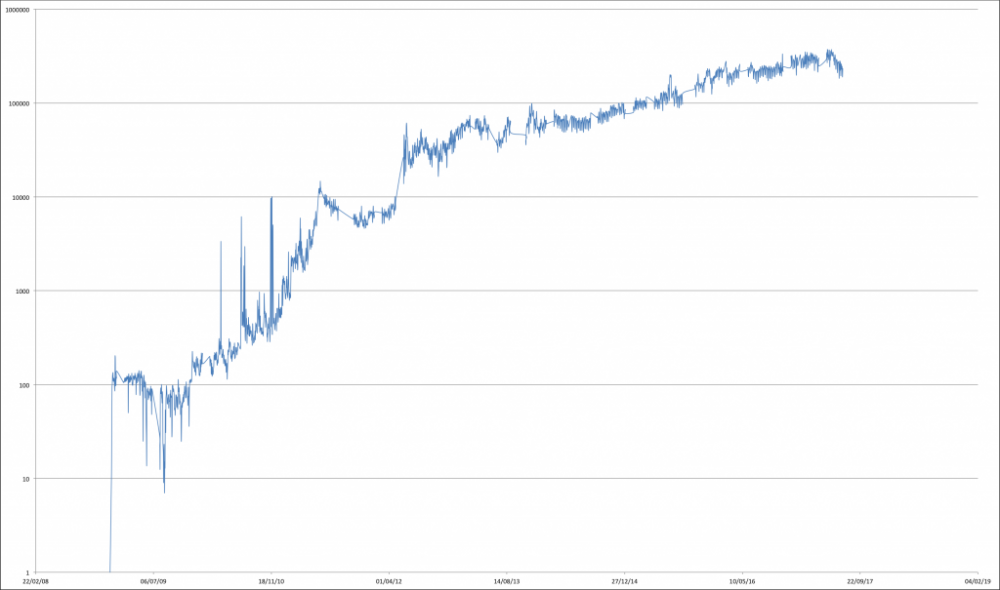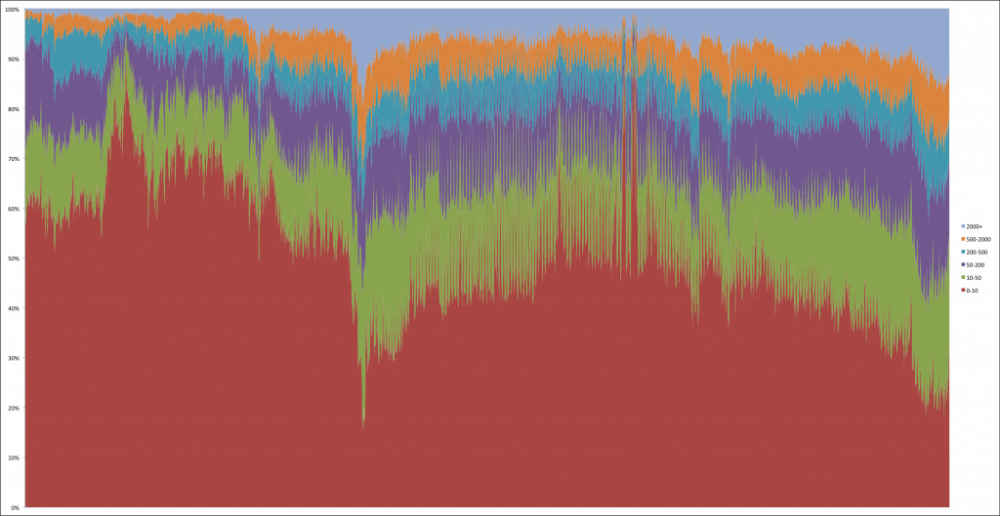用java简单分析下比特币区块链
我假设你已经对比特币的含义有一个模糊的概念,并且你对交易背后的机制有一个简单的理解:对地址进行支付(这是匿名的,因为它们不能直接链接到特定的个人),所有交易都是公开的。交易以块的形式收集,块在区块链中链接在一起。
你可以将区块链视为一个不断更新且可供所有人访问的大型数据库。你可以使用Bitcoin Core等软件下载完整的区块链。安装软件后,你的安装需要几周时间才能同步完成。请注意,在撰写本文时,区块链的大小超过130Gb,请考虑到这一点……
如果你有可用的区块链数据(不一定是整个区块链,你也可以使用它的子集),可以使用Java进行分析。你可以从头开始完成所有工作并从文件中读取原始数据等。让我们跳过此步骤并改为使用库。大多数编程语言都有几种选择。我将使用Java和bitcoinj库。这是一个大型库,可用于构建钱包,在线支付等应用程序。我将使用它的解析功能。
首先在 https://bitcoinj.github.io/ 下载该库的jar文件(我正在使用 https://search.maven.org/remotecontent?filepath=org/bitcoinj/bitcoinj-core/0.14.4/bitcoinj-core-0.14.4-bundled.jar )。然后,下载 SLF4J ,解压缩,然后获取名为slf4j-simple-x.y.z.jar的文件(在我的例子中:slf4j-simple-1.7.25.jar)。将这两个jar文件添加到类路径中,你就可以开始了。
让我们从一个简单的例子开始:计算(然后绘制)每天的交易数量。这是代码,注释很多。
import java.io.File;
import java.text.SimpleDateFormat;
import java.util.LinkedList;
import java.util.List;
import java.util.HashMap;
import java.util.Locale;
import java.util.Map;
import org.bitcoinj.core.Block;
import org.bitcoinj.core.Context;
import org.bitcoinj.core.NetworkParameters;
import org.bitcoinj.core.Transaction;
import org.bitcoinj.params.MainNetParams;
import org.bitcoinj.utils.BlockFileLoader;
public class SimpleDailyTxCount {
// Location of block files. This is where your blocks are located.
// Check the documentation of Bitcoin Core if you are using
// it, or use any other directory with blk*dat files.
static String PREFIX = "/path/to/your/bitcoin/blocks/";
// A simple method with everything in it
public void doSomething() {
// Just some initial setup
NetworkParameters np = new MainNetParams();
Context.getOrCreate(MainNetParams.get());
// We create a BlockFileLoader object by passing a list of files.
// The list of files is built with the method buildList(), see
// below for its definition.
BlockFileLoader loader = new BlockFileLoader(np,buildList());
// We are going to store the results in a map of the form
// day -> n. of transactions
Map<String, Integer> dailyTotTxs = new HashMap<>();
// A simple counter to have an idea of the progress
int blockCounter = 0;
// bitcoinj does all the magic: from the list of files in the loader
// it builds a list of blocks. We iterate over it using the following
// for loop
for (Block block : loader) {
blockCounter++;
// This gives you an idea of the progress
System.out.println("Analysing block "+blockCounter);
// Extract the day from the block: we are only interested
// in the day, not in the time. Block.getTime() returns
// a Date, which is here converted to a string.
String day = new SimpleDateFormat("yyyy-MM-dd").format(block.getTime());
// Now we start populating the map day -> number of transactions.
// Is this the first time we see the date? If yes, create an entry
if (!dailyTotTxs.containsKey(day)) {
dailyTotTxs.put(day, 0);
}
// The following is highly inefficient: we could simply do
// block.getTransactions().size(), but is shows you
// how to iterate over transactions in a block
// So, we simply iterate over all transactions in the
// block and for each of them we add 1 to the corresponding
// entry in the map
for ( Transaction tx: block.getTransactions() ) {
dailyTotTxs.put(day,dailyTotTxs.get(day)+1);
}
} // End of iteration over blocks
// Finally, let's print the results
for ( String d: dailyTotTxs.keySet()) {
System.out.println(d+","+dailyTotTxs.get(d));
}
} // end of doSomething() method.
// The method returns a list of files in a directory according to a certain
// pattern (block files have name blkNNNNN.dat)
private List<File> buildList() {
List<File> list = new LinkedList<File>();
for (int i = 0; true; i++) {
File file = new File(PREFIX + String.format(Locale.US, "blk%05d.dat", i));
if (!file.exists())
break;
list.add(file);
}
return list;
}
// Main method: simply invoke everything
public static void main(String[] args) {
SimpleDailyTxCount tb = new SimpleDailyTxCount();
tb.doSomething();
}
}
此代码将在屏幕上打印“日期,交易次数”形式的值列表。只需将输出重定向到文件并绘制它。你应该得到这样的东西(注意每日交易数量几乎呈指数增长):

我对这个库的性能印象非常深刻:使用上面的代码扫描整个区块链在我的笔记本电脑(2014 MacBook Pro)上花了大约35分钟,区块链存储在使用USB2端口连接的外部HD上。它最多占用了一个处理器和1 Gb RAM的大约100%。
一个稍微复杂的例子花了55分钟:计算交易规模的每日分布。这需要在上面的代码中添加另一个循环来检索所有交易输出(以及沿途的一些计数器)。区间是0-10美元,10-50美元,50-200美元,200-500美元,500-2000美元,2000+USD(BTC/美元汇率通过取当天平均开盘价和收盘价计算得出)。

======================================================================
分享一些以太坊、EOS、比特币等区块链相关的交互式在线编程实战教程:
- java以太坊开发教程,主要是针对java和android程序员进行区块链以太坊开发的web3j详解。
- python以太坊,主要是针对python工程师使用web3.py进行区块链以太坊开发的详解。
- php以太坊,主要是介绍使用php进行智能合约开发交互,进行账号创建、交易、转账、代币开发以及过滤器和交易等内容。
- 以太坊入门教程,主要介绍智能合约与dapp应用开发,适合入门。
- 以太坊开发进阶教程,主要是介绍使用node.js、mongodb、区块链、ipfs实现去中心化电商DApp实战,适合进阶。
- C#以太坊,主要讲解如何使用C#开发基于.Net的以太坊应用,包括账户管理、状态与交易、智能合约开发与交互、过滤器和交易等。
- EOS教程,本课程帮助你快速入门EOS区块链去中心化应用的开发,内容涵盖EOS工具链、账户与钱包、发行代币、智能合约开发与部署、使用代码与智能合约交互等核心知识点,最后综合运用各知识点完成一个便签DApp的开发。
- java比特币开发教程,本课程面向初学者,内容即涵盖比特币的核心概念,例如区块链存储、去中心化共识机制、密钥与脚本、交易与UTXO等,同时也详细讲解如何在Java代码中集成比特币支持功能,例如创建地址、管理钱包、构造裸交易等,是Java工程师不可多得的比特币开发学习课程。
- php比特币开发教程,本课程面向初学者,内容即涵盖比特币的核心概念,例如区块链存储、去中心化共识机制、密钥与脚本、交易与UTXO等,同时也详细讲解如何在Php代码中集成比特币支持功能,例如创建地址、管理钱包、构造裸交易等,是Php工程师不可多得的比特币开发学习课程。
- tendermint区块链开发详解 ,本课程适合希望使用tendermint进行区块链开发的工程师,课程内容即包括tendermint应用开发模型中的核心概念,例如ABCI接口、默克尔树、多版本状态库等,也包括代币发行等丰富的实操代码,是go语言工程师快速入门区块链开发的最佳选择。
汇智网原创翻译,转载请标明出处。这里是原文 用java简单分析下比特币区块链
- 本文标签: db 数据库 NSA 智能 key build Go语言 mongo rmi node tar IDE CTO Document 同步 处理器 工程师 remote 数据 注释 解析 final 下载 模型 端口 js UI 时间 MongoDB 开发 笔记本电脑 id https 安装 代码 Android 入门教程 python 希望 翻译 git map GitHub 初学者 REST http IO PHP ip 密钥 Node.js 程序员 软件 core ORM LinkedList web maven cat 管理 App list src Action HashMap java
- 版权声明: 本文为互联网转载文章,出处已在文章中说明(部分除外)。如果侵权,请联系本站长删除,谢谢。
- 本文海报: 生成海报一 生成海报二











![[HBLOG]公众号](http://www.liuhaihua.cn/img/qrcode_gzh.jpg)

